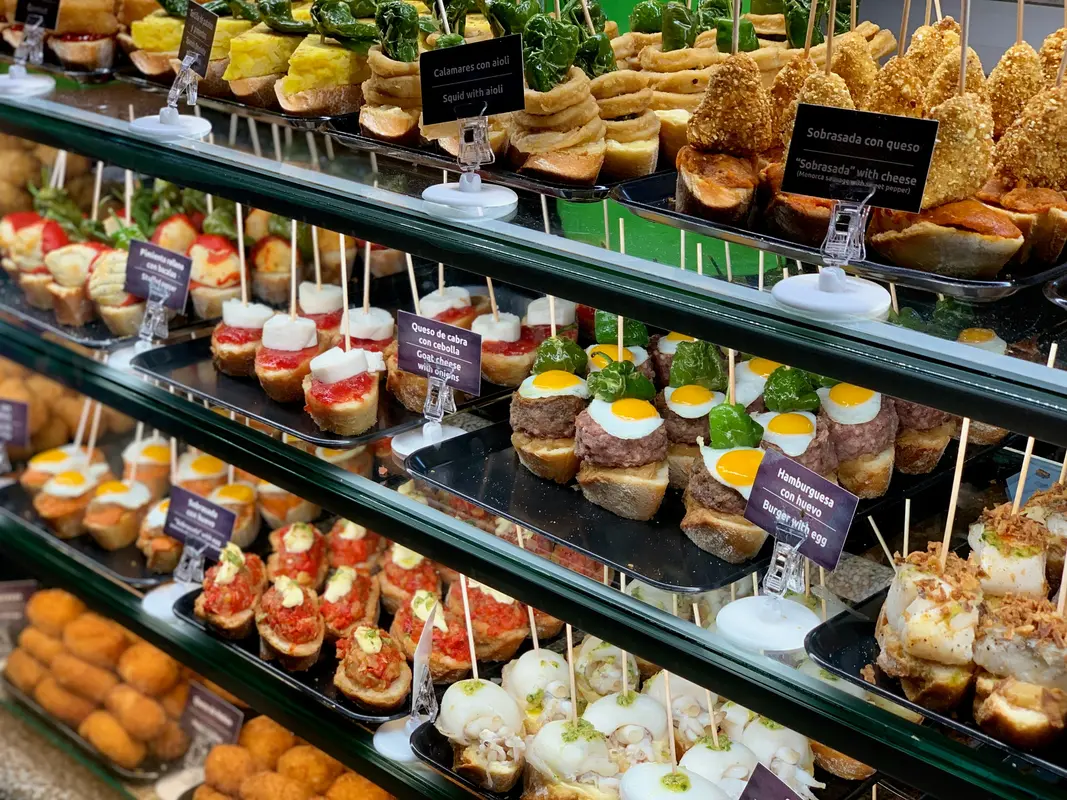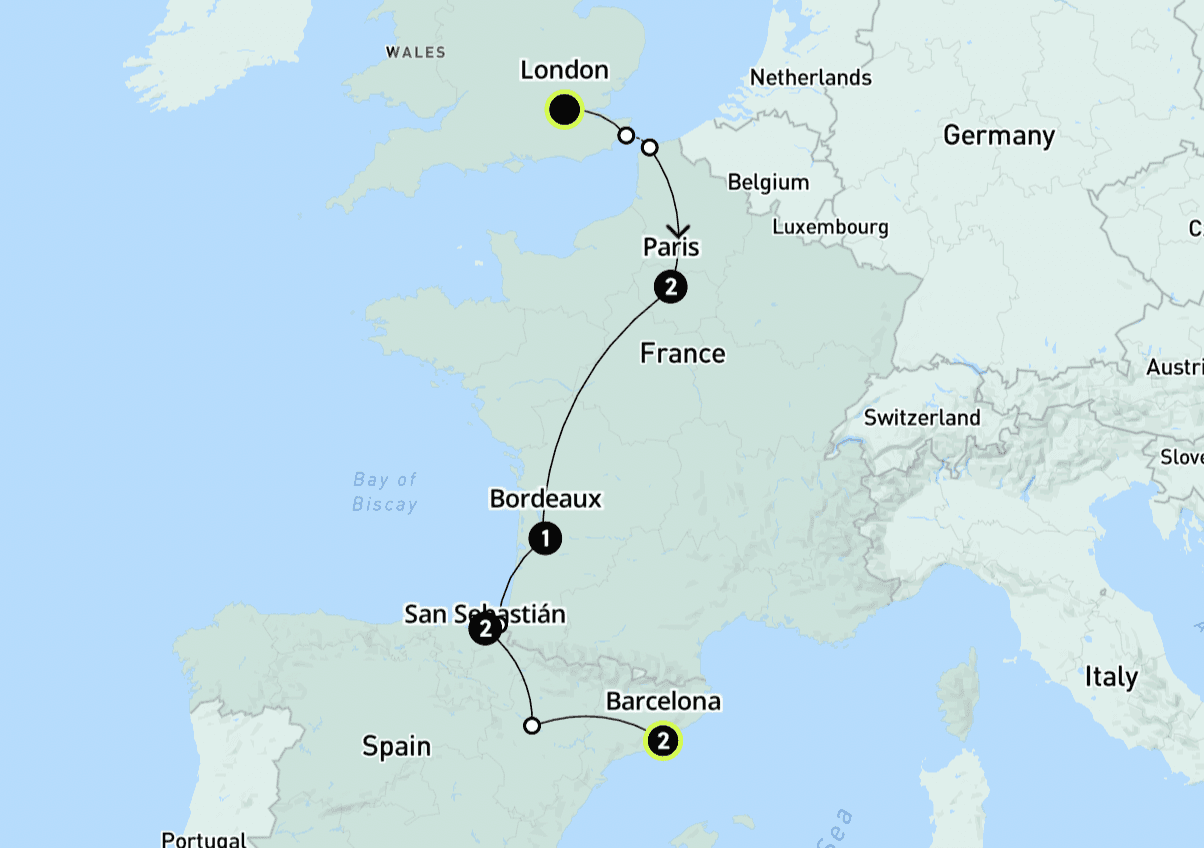Imagine sitting in a sun-drenched plaza in Seville, a glass of tinto de verano in hand.
Around you, small plates arrive — golden croquetas, garlic prawns sizzling in oil, and crispy patatas bravas. Spanish starters aren’t just food; they’re a celebration of flavor, culture, and shared moments.
In this guide, you’ll explore must-try Spanish starter dishes, tips to order like a local, and simple recipes to recreate at home.
Whether you’re dining in Spain or hosting a tapas night, you’ll discover the magic of Spanish starters that brings everyone together. ¡Buen provecho!

Imagine sitting in a sun-drenched plaza in Seville, a cold glass of tinto de verano in hand. Around you, small plates of food — golden croquetas, garlic prawns sizzling in oil, and bowls of spicy patatas bravas — arrive at your table like little gifts of flavor. This isn’t just a meal; it’s a celebration of life, culture, and shared moments.
Welcome to the world of Spanish starters.
Whether you’re planning a trip to Spain or recreating tapas at home, this guide will be your go-to resource for:
Must-try Spanish starter dishes.
Tips to order like a local (including key phrases in Spanish).
Easy Spanish recipes for starters to impress your friends and family.
By the time you’re done, you’ll know exactly what to order, what to cook, and — most importantly — how to share incredible stories and photos that scream, “I’ve nailed Spanish food culture!”
Let’s get started with the basics.
What Are Spanish Starters? A Bite-Sized Introduction
Spanish starters, often referred to as tapas or raciones, are small dishes served at the start of a meal or alongside drinks. These appetizers aren’t just food; they represent the heart of Spain’s communal and relaxed dining culture.
The Origin of Tapas
The word “tapa” comes from the Spanish verb tapar, meaning “to cover.” Legend has it that bartenders in Andalusia used slices of bread or meat to cover drinks and keep flies away. Over time, these “covers” evolved into the small, flavorful dishes we know today.
Tapas vs. Starters: What’s the Difference?
Tapas: Small portions meant to accompany drinks. Tapas are often served for free in certain regions like Granada.
Starters (Entrantes): The first course of a meal, served before the main dish. These dishes can be larger than tapas but are still shareable.
Pintxos: Bite-sized snacks popular in the Basque Country, often served on skewers or bread.
Whether it’s a casual drink with friends or a formal meal, Spanish starters offer something for every occasion — and they’re perfect for sampling a wide range of flavors without overindulging.
Top 10 Must-Try Spanish Starter Dishes
If you’re visiting Spain, these iconic dishes need to be on your food bucket list. Each starter tells a story of tradition, simplicity, and bold flavors.
1. Patatas Bravas
Crispy fried potatoes smothered in a spicy tomato-based sauce (salsa brava) and creamy aioli. This dish is a staple on every tapas menu and offers the perfect mix of crunch and zest.
Why Try It?: It’s one of the most beloved and Instagrammable Spanish starter dishes.
Where to Find It: Every tapas bar in Spain — but the best versions often come from Madrid.

2. Gambas al Ajillo
Picture this: juicy prawns sizzling in bubbling olive oil, garlic, and a touch of chili. Gambas al ajillo is a showstopper, both in flavor and presentation.
Why Try It?: It’s a must for seafood lovers and an easy dish to recreate at home.
Pro Tip: Use the leftover garlic oil as a dip for fresh bread — trust us, it’s heavenly.
3. Tortilla Española
This isn’t just any omelette. Tortilla Española (Spanish omelette) combines layers of tender potatoes, onions, and eggs into a thick, satisfying starter.
Why Try It?: It’s filling, simple, and loved by everyone. Plus, it’s often served at room temperature, making it a great snack throughout the day.
4. Croquetas de Jamón
These creamy, crispy bites are made of béchamel sauce mixed with diced cured ham (jamón) and then deep-fried to golden perfection.
Why Try It?: It’s comfort food in its finest form and a must on any Spanish food starter menu.

5. Pimientos de Padrón
Small green peppers fried in olive oil and sprinkled with sea salt. Here’s the fun part: most are mild, but every so often, you’ll get a spicy one — it’s like food roulette!
Why Try It?: A light, vegetarian-friendly option that’s also great for sharing.
Where to Find It: Common in Galicia, but available in tapas bars across Spain.
6. Pan con Tomate
Sometimes the simplest dishes are the best. Pan con tomate is toasted bread rubbed with garlic, topped with fresh tomato puree, olive oil, and a pinch of salt.
Why Try It?: It’s quick, healthy, and a quintessential Spanish starter.
7. Boquerones en Vinagre
These are fresh anchovies marinated in vinegar, garlic, and olive oil — a dish that bursts with acidity and flavor.
Why Try It?: It’s light, refreshing, and a favorite among seafood lovers.
8. Albondigas
Spanish-style meatballs served in a rich tomato sauce. Unlike Italian meatballs, these are smaller and often spiced with paprika.
Why Try It?: Perfect for meat lovers and hearty enough to keep you going all day.
9. Chorizo al Vino Tinto
Slices of spicy chorizo sausage cooked in red wine until tender and infused with flavor.
Why Try It?: Combines two Spanish essentials: chorizo and vino tinto.
10. Salmorejo
A creamy, cold tomato soup made with tomatoes, bread, garlic, and olive oil — richer and smoother than gazpacho.
Why Try It?: A refreshing starter, especially in the heat of summer.

These dishes are not only delicious but also perfect for sharing, photographing, and bragging about when you return home. Whether you’re in Madrid, Barcelona, or Seville, you’ll find these starters on any Spanish food menu.
How to Order Spanish Starters Like a Local
One of the most exciting parts of visiting Spain is dining like a local. But let’s face it — walking into a bustling tapas bar and trying to navigate a Spanish menu can feel a bit intimidating. Don’t worry! This section will teach you the phrases, tips, and tricks you need to confidently order the best Spanish starters and immerse yourself in Spain’s food culture.
Key Phrases for Ordering Starters in Spanish
Learning a few simple phrases will not only help you get the dishes you want but will also impress the locals and show respect for their culture.
¿Qué tapas recomienda? – What tapas do you recommend?
Quisiera una ración de… – I’d like a portion of...
¿Me puede traer la carta, por favor? – Can you bring me the menu, please?
Una tapa de patatas bravas, por favor. – A tapa of patatas bravas, please.
¿Esto lleva carne? – Does this have meat? (Perfect for vegetarians.)
La cuenta, por favor. – The bill, please.
In many smaller, local tapas bars, the dishes might not be listed on a printed menu. Instead, look for a chalkboard (la pizarra) or ask the server for recommendations.
Understanding Tapas Terminology
To avoid confusion when ordering, it’s helpful to know the different serving sizes and types of starters:
Tapas: Small plates, often served with drinks.
Raciones: Larger portions meant for sharing, usually ordered for the table.
Media ración: Half a portion — perfect if you want to try more dishes.
Pintxos: Bite-sized snacks typically served on bread or skewers (popular in Northern Spain).
For example, if you’re craving croquetas, you might ask for:
Una tapa de croquetas (a small plate of croquettes) if you’re just nibbling.
Una ración de croquetas if you’re sharing with friends.
Regional Tips for Ordering Tapas
Ordering starters can vary depending on where you are in Spain:
In Granada: Tapas are often served free with your drink. The more drinks you order, the more small dishes you get!
In Madrid: Tapas bars often serve media raciones or raciones to accommodate larger groups.
In San Sebastián: Pintxos are displayed on the bar, and you take what you like. You’ll settle the bill based on the toothpicks or plates you’ve collected.
Easy Spanish Starter Recipes to Try at Home
Now that you know how to navigate tapas culture like a pro, why not bring Spain to your kitchen? These easy recipes for classic Spanish starter dishes will impress guests, are simple to prepare, and capture the authentic flavors of Spain.
1. Patatas Bravas
Ingredients:
4 medium potatoes, peeled and cubed
2 tablespoons olive oil
2 cloves garlic, minced
1 teaspoon smoked paprika
1/2 teaspoon chili flakes (optional)
1/2 cup tomato puree
Salt to taste
Aioli (mayonnaise mixed with garlic)
Instructions:
Preheat your oven to 220°C (425°F). Toss the cubed potatoes in olive oil and a pinch of salt, then roast them for 30-35 minutes until crispy.
In a pan, heat a tablespoon of olive oil and sauté the garlic. Add the smoked paprika, chili flakes, and tomato puree. Cook for 5-7 minutes until the sauce thickens.
Drizzle the spicy sauce over the potatoes and top with a dollop of aioli. Serve hot!
For an extra crunch, fry the potatoes instead of roasting them.
2. Pan con Tomate (Tomato Bread)
Ingredients:
4 slices of crusty bread (like ciabatta)
2 ripe tomatoes
1 clove garlic
Extra virgin olive oil
Sea salt
Instructions:
Toast the bread slices until golden brown.
Cut the garlic clove in half and rub it lightly on the warm bread.
Grate the tomatoes into a bowl, discarding the skin. Add a pinch of sea salt and a drizzle of olive oil.
Spoon the tomato mixture onto the bread and serve immediately.
This dish is simple, healthy, and tastes like summer in Spain.
3. Gambas al Ajillo (Garlic Prawns)
Ingredients:
1/2 pound (250g) prawns, peeled and deveined
4 cloves garlic, thinly sliced
1/4 cup olive oil
1 teaspoon chili flakes
Fresh parsley for garnish
Salt to taste
Instructions:
Heat the olive oil in a skillet over medium heat. Add the garlic and chili flakes and cook until the garlic is fragrant but not browned.
Add the prawns and sauté for 2-3 minutes until they turn pink and opaque.
Sprinkle with parsley and a pinch of salt. Serve hot with crusty bread to soak up the garlic oil.
Serving Suggestion: Pair with a glass of Albariño (a Spanish white wine) for the ultimate experience.

4. Pimientos de Padrón
Ingredients:
200g Padrón peppers
2 tablespoons olive oil
Coarse sea salt
Instructions:
Heat the olive oil in a large skillet. Add the peppers and cook over medium-high heat, stirring occasionally, until they blister and soften (about 5 minutes).
Sprinkle generously with sea salt and serve immediately.
About 1 in 10 Padrón peppers is surprisingly spicy — it’s part of the fun!
5. Tortilla Española (Spanish Omelette)
Ingredients:
4 large potatoes, peeled and sliced thinly
1 onion, sliced thinly
6 large eggs
1/2 cup olive oil
Salt to taste
Instructions:
Heat olive oil in a pan over medium heat. Add the potatoes and onions, cooking until tender but not crispy (about 15 minutes). Drain the excess oil.
Beat the eggs in a large bowl and season with salt. Add the cooked potatoes and onions and mix well.
Return the mixture to the pan and cook over low heat, flipping once to cook both sides evenly.
Let it cool slightly, slice into wedges, and serve.
Serve your tortilla warm or at room temperature with a simple green salad.

These recipes bring a taste of Spain straight to your table and are perfect for dinner parties, weekend treats, or casual meals.
Fun Facts: The Culture and History Behind Spanish Starters
Spanish starters are more than just food — they’re a window into Spain’s history, culture, and way of life. These bite-sized dishes have fascinating stories that make them even more special.
1. Tapas Were Born Out of Necessity
As mentioned earlier, tapas originated as small covers to protect drinks. However, they also served another purpose: keeping patrons sober. Bartenders began serving salty snacks like olives and ham alongside drinks to encourage slow, steady sipping.
2. Free Tapas Still Exist in Parts of Spain
While most tapas are ordered and paid for, some regions (especially Granada) still honor the tradition of free tapas. Order a drink, and you’ll receive a small plate of food — sometimes simple, sometimes surprisingly elaborate — at no extra charge.
3. Each Region Has Its Own Specialties
Spain is incredibly diverse, and each region has its unique starters:
Andalusia: Salmorejo and boquerones.
Catalonia: Pan con tomate and escalivada (grilled vegetables).
Basque Country: Pintxos, often served with seafood or cured meats.
Madrid: Callos a la Madrileña (tripe stew).
Galicia: Pimientos de Padrón and pulpo a la gallega (Galician octopus).
4. Tapas Are About Sharing and Socializing
Tapas culture reflects Spain’s communal way of life. Meals are rarely rushed; they’re enjoyed slowly, surrounded by friends and family. Sharing plates fosters conversation, laughter, and connection — a tradition travelers quickly fall in love with.

5. The World’s Biggest Tortilla Española
The Spanish love their tortilla. In 2014, chefs in Vitoria-Gasteiz created the world’s largest Spanish omelette, weighing an incredible 1,600 kilograms and using over 16,000 eggs!
Why Spanish Starters Are a Must-Try for Every Traveler
Spanish starters are more than just food — they’re an experience that combines flavor, tradition, and the joy of discovery. Whether you’re dining in Spain or recreating the dishes at home, these small plates bring something unique to your table.
1. A Taste of Authentic Spanish Culture
Each dish tells a story of Spain’s rich culinary heritage. From the humble origins of pan con tomate in Catalonia to the seafood-based starters of Galicia, every bite gives you a sense of place and tradition. Eating Spanish starters is a delicious way to connect with the history and culture of the regions you visit.
2. Perfect for Adventurous Foodies
One of the joys of Spanish starters is the variety — you can sample multiple dishes in one sitting. If you’re a food lover, exploring starters like boquerones en vinagre, tortilla Española, or pimientos de Padrón is an adventure for your taste buds.
Not sure what to order? Ask the server for their recommendations — you might discover a new favorite!
3. Shareable Dining, Spanish-Style
Tapas and starters are all about sharing. Meals in Spain are relaxed, social, and designed for groups. Ordering a mix of raciones or tapas encourages you to try different flavors together, turning dining into a memorable, communal experience.
Whether it’s a plate of croquetas de jamón passed around the table or fried chorizo al vino tinto enjoyed over conversation, sharing Spanish starters brings people closer — just like the Spaniards do.

4. An Easy Way to Recreate Spain at Home
You don’t have to book a flight to enjoy Spanish starters! Many dishes are easy to prepare at home with simple ingredients. From the crispy goodness of patatas bravas to the quick and satisfying pan con tomate, these recipes will bring the spirit of Spanish dining into your kitchen.
Host a tapas night with friends or family, serve a selection of starters, and enjoy an authentic taste of Spain without leaving your home.
Spanish Starters: FAQs
To wrap things up, here are answers to some of the most common questions about Spanish starters:
What’s the Difference Between Tapas and Starters?
Tapas are small, shareable plates often served with drinks, while starters (entrantes) are slightly larger and serve as the first course of a formal meal.
Are Spanish Starters Vegetarian-Friendly?
Absolutely! Options like Pimientos de Padrón, Pan con tomate, and Tortilla Española are vegetarian. Many tapas bars also offer vegetable-based dishes like grilled peppers or mushrooms.
What Drinks Pair Best with Spanish Starters?
Tinto de Verano: A refreshing red wine spritzer.
Sangria: Classic, fruity, and perfect with tapas.
Cava: Spain’s sparkling wine pairs beautifully with salty dishes like boquerones.
Sherry (Jerez): Popular in Andalusia, it’s ideal with seafood starters.

How Much Do Tapas Cost in Spain?
The cost can vary:
Free: In places like Granada, tapas are complimentary with drinks.
€2-€4: Standard tapas in local bars.
€5-€10: Larger raciones (portions) or premium tapas in trendy bars.
Where Can I Find the Best Spanish Starters?
Madrid: Mercado de San Miguel for iconic tapas.
Barcelona: La Boqueria Market for fresh ingredients and classic dishes.
Seville: The heart of Andalusian tapas culture.
San Sebastián: Famous for its pintxos.
Savor the Magic of Spanish Starters
Spanish starters aren’t just a prelude to a meal — they’re a cultural experience. Whether you’re tasting free tapas in Granada, navigating a pintxos bar in San Sebastián, or making Patatas Bravas in your own kitchen, every dish tells a story.
From crispy potatoes and sizzling prawns to refreshing salmorejo, Spain’s starters are perfect for:
Discovering bold, authentic flavors.
Sharing meals with friends and family.
Capturing social currency with Instagram-worthy photos and unforgettable experiences.
Ready to Try It?
Which Spanish starter are you excited to try first?
Have you tasted any of these dishes during your travels? Share your favorite Spanish food stories in the comments below!
Planning a trip to Spain? Bookmark this guide, and you’ll be ready to order like a pro.
¡Buen provecho! 🇪🇸 (Enjoy your meal aka Bon Appetit)
FAQS Travel to Paradiso
Recent Posts
















